The age-old belief that dogs and cats can’t get along is not always true. In fact, many families successfully raise both pets together in the same household, and they can become best friends. However, this doesn’t happen by chance; it requires careful planning, patience, and proper training. Whether you’re bringing a dog into a home with an existing cat, or introducing a cat to a dog, knowing how to facilitate a peaceful and happy coexistence is key. In this guide, we’ll discuss essential tips on how to raise dogs and cats together, ensuring a harmonious living environment.
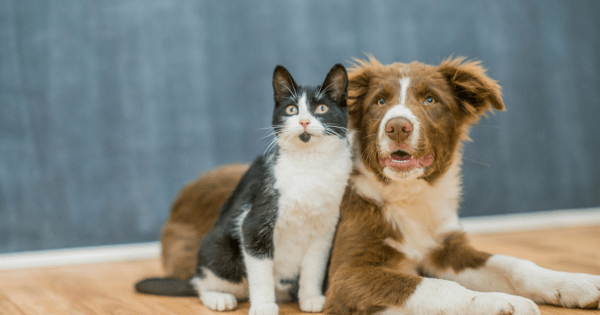
1. Understanding the Natural Differences Between Dogs and Cats
Before diving into how to raise them together, it’s important to understand the natural differences between dogs and cats, as these will influence how they interact with one another.
- Territorial behavior: Cats are generally more territorial than dogs, and they value personal space. Dogs, on the other hand, may be more social and seek interaction.
- Communication styles: Dogs and cats have very different communication methods. Dogs often wag their tails when happy, while a wagging tail in a cat can indicate agitation. Recognizing these communication differences can help prevent misunderstandings.
- Energy levels: Many dogs are more active and energetic than cats, which may cause stress for a more laid-back cat if boundaries aren’t respected.
- Predatory instincts: Some dogs have a strong prey drive, which could lead them to chase cats. Certain dog breeds, like terriers, have stronger hunting instincts, making it important to consider the breed’s tendencies when introducing them to cats.
Understanding these differences helps you create an environment where both pets can feel comfortable.
2. Choosing the Right Dog or Cat for a Multi-Pet Household
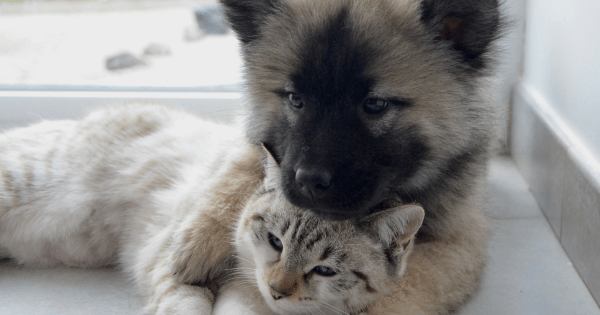
If you’re introducing a new pet into a home with an existing dog or cat, it’s essential to choose a pet with the right temperament. Some animals are naturally more social and tolerant, while others may prefer a quieter, single-pet environment.
2.1. Consider the Age and Temperament
- Kittens and puppies: Introducing a kitten and a puppy together is often easier because they will grow up learning to coexist. They are more adaptable and open to forming bonds at a young age.
- Adult pets: Introducing adult pets requires more time and effort, but it can still be successful. Make sure to consider the temperament of both animals. For example, if you have an older cat that’s shy or reserved, it may not appreciate the high energy of a young, excitable dog.
- Breed matters: Some dog breeds are naturally more cat-friendly. Breeds like Golden Retrievers, Labrador Retrievers, and Basset Hounds tend to be more laid-back and better suited for homes with cats.
2.2. Look for Signs of Compatibility
Before bringing a new pet into your home, consider arranging a meet-and-greet in a neutral setting, such as a park or the house of a friend, where both pets can get to know each other in a controlled environment. Look for positive signs of interaction, such as curiosity without aggression or calm behavior.
3. Introducing a Dog and Cat for the First Time
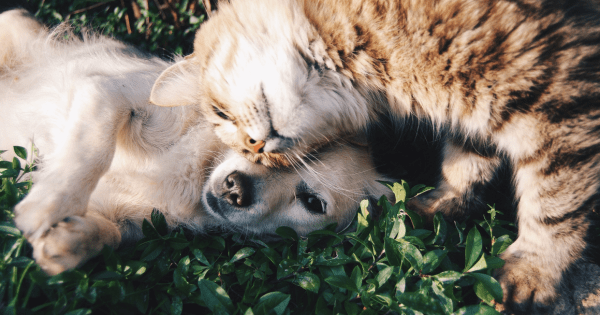
Introducing a dog and cat is a delicate process that should be done gradually to avoid overwhelming either pet. Here’s a step-by-step guide on how to safely introduce a dog and a cat:
3.1. Create Separate Spaces
Initially, keep your dog and cat in separate rooms. This gives both animals time to adjust to the new smells and sounds without the pressure of a face-to-face meeting. Allow them to explore each other’s scent by swapping bedding or toys between them. This allows them to get used to each other’s presence without direct contact.
3.2. Slow Introductions

Once both pets have had time to adjust to the new scents, begin introducing them slowly. Start with short, supervised interactions where they can see each other but not touch. Use a baby gate or keep the dog on a leash to prevent any sudden moves. Reward calm behavior from both pets with treats and praise.
3.3. Use Positive Reinforcement
Positive reinforcement is essential when training both dogs and cats to coexist. Every time they interact calmly or show curiosity without aggression, reward them. This builds positive associations with the presence of the other animal.
3.4. Be Patient
Don’t rush the process. It can take days, weeks, or even months for a dog and cat to fully accept each other. Patience is key, and pushing the interaction too quickly can lead to negative experiences that might be difficult to reverse.
4. Managing Coexistence: Living Together Harmoniously
Once your dog and cat have been introduced and are comfortable in each other’s presence, the next step is to ensure they live together harmoniously.
4.1. Provide Personal Space for Both Pets
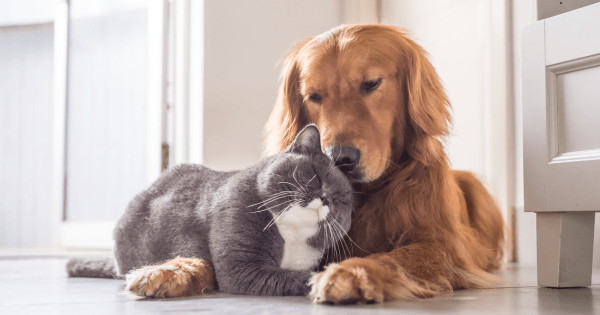
Dogs and cats have different needs for personal space, so it’s important to provide both animals with their own safe zones. For cats, this might include elevated areas, like cat trees or shelves, where they can observe without being disturbed. Dogs should have their own beds or crates where they can retreat for quiet time. Respecting their need for space helps prevent territorial issues and keeps both pets happy.
4.2. Separate Feeding Areas
Dogs and cats should have separate feeding areas to prevent competition or aggression over food. Cats, in particular, can feel stressed if they are forced to eat in a busy or noisy area. Place the cat’s food bowl in a quiet, elevated location where the dog can’t reach it. Similarly, ensure the dog’s feeding area is away from distractions.
4.3. Regular Exercise and Playtime
Both dogs and cats need exercise and mental stimulation, but their play styles are different. Dogs often enjoy high-energy games like fetch or running, while cats prefer quieter activities like stalking toys or climbing. Ensure both pets have separate play sessions to prevent frustration.
At the same time, encourage gentle, supervised play between them. Some dogs and cats learn to play together, especially if they grow up together. However, always monitor these interactions to ensure safety, especially in the early stages of their relationship.
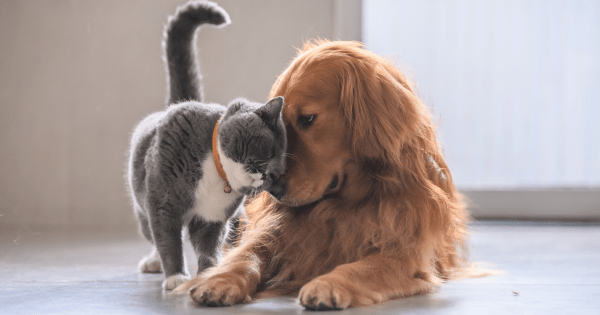
4.4. Training for Good Behavior
Training your dog for good behavior around your cat is essential. Commands such as “leave it” and “stay” can be lifesavers in preventing unwanted chasing or rough play. If your dog has a strong prey drive, you may need to work with a professional trainer to ensure they don’t view your cat as something to chase.
For cats, litter box training should be a priority, and you may want to place the litter box in an area the dog cannot access. Some dogs have a habit of getting into litter boxes, so an elevated or closed-off location can solve this issue.
5. Addressing Behavioral Issues
Even with the best efforts, conflicts may still arise. Here’s how to address some common behavioral problems between dogs and cats:
5.1. Dog Chasing the Cat
Dogs may instinctively chase cats, especially if they are excitable or high-energy breeds. If this happens, interrupt the behavior immediately with a firm command like “no” or “leave it,” and redirect the dog’s attention with a toy or treat. Never encourage chasing, as it can lead to fear or injury.
5.2. Cat Swatting or Hissing

Cats may swat or hiss if they feel threatened by the dog’s presence. This is often a defensive behavior. Give your cat space to retreat and let them feel safe. Over time, as they grow more comfortable, these behaviors should decrease. If your cat continues to act aggressively, it may help to reintroduce the pets gradually.
5.3. Jealousy and Attention-Seeking
Both dogs and cats can become jealous if they feel they’re not getting enough attention. Make sure you’re spending quality time with both pets to prevent feelings of neglect. Create separate bonding times for each pet, ensuring they both feel loved and cared for.
6. Creating a Harmonious Home for Both Dogs and Cats
Raising dogs and cats together in the same household can be a rewarding experience, but it requires careful planning, patience, and commitment. By understanding their natural differences, introducing them properly, and managing their coexistence with separate spaces and positive reinforcement, you can create a peaceful and happy environment for both pets. With time, your dog and cat may not only tolerate each other but form a unique bond that enriches your household in ways you never expected.
